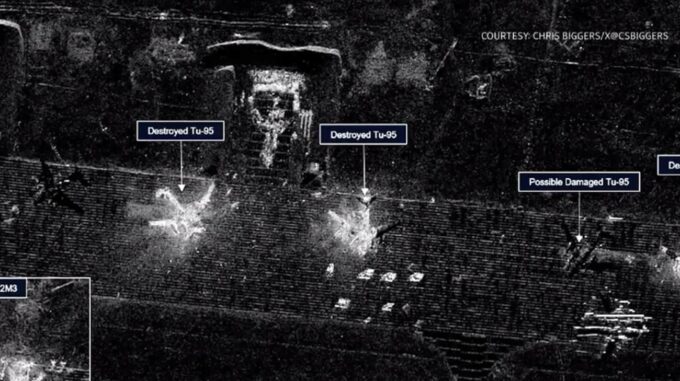Journalists obtained the first satellite images indicating extensive destruction at the Russian airbase “Belyaeva” in Irkutsk Oblast

These images show the aftermath of a major strike carried out by Ukrainian drones during the night of June 1, confirming the severity of the damage and the high effectiveness of the operation conducted by Ukrainian special services. The information provided by Radio Free Europe from satellite images demonstrates that at least 11 Russian strategic bombers were destroyed during this special operation. This is the result of a large-scale attack carried out as part of the "Pavutina" operation by the Security Service of Ukraine (SBU). According to sources, the destruction of seven Tu-95 bombers—Russia’s main strategic aircraft—as well as four Tu-22 M3s and one An-12 transport aircraft (not belonging to the strategic air group) has been confirmed. Telegram channels and official sources emphasize that at the Belyaeva airfield, the destruction of four Tu-22s and three Tu-95s has been verified. One more Tu-95 is likely damaged, which may complicate its further use or require additional repairs. These details confirm the high precision of Ukrainian strikes and the ability to control the scale of damage even in territories previously unreachable by such means. The background of this operation dates back to June 1, when Ukrainian special services launched a major "Pavutina" operation aimed at striking Russian strategic airbases and destroying key Russian aviation targets at four airfields. According to Vasyl Maliuk, head of the SBU, approximately 34% of Russia’s strategic aircraft carriers at these bases were destroyed, and over 40 aircraft of various types were damaged. Official statistics report that 41 Russian strategic aviation aircraft, including A-50s, Tu-95s, Tu-22 M3s, and Tu-160s, were targeted in this operation. Experts estimate the value of the damaged aircraft at over 7 billion US dollars, significantly weakening Russian strategic aviation and prompting its leadership to reassess their defense strategies. This operation stands as a vivid confirmation of Ukraine’s ability to effectively strike strategic targets of the aggressor on foreign territory. At the same time, it exemplifies how modern drone technology and satellite reconnaissance can alter the regional balance, reducing the opponent’s advantage in strategic warfare. It should be noted that Ukrainian special services do not intend to stop—strategic strikes, according to them, will continue to coordinate and enhance the country’s defensive capabilities. Understanding the extent of destruction and the precision of hits demonstrates a new level of Ukraine’s tactical and strategic relative advantage, with satellite images serving as valuable proof of success in the fight for national security and independence. Meanwhile, Russia is already beginning to analyze the losses and changes in its defense plans, seeking to avoid further damage and strengthen its countermeasures against Ukrainian attacks—though full victory is still far away.

